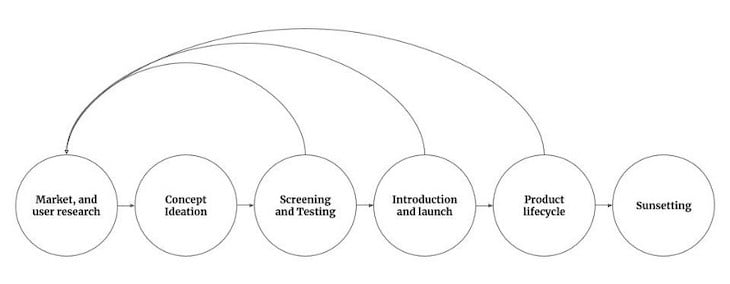Whenever I read about the next hot, new start-up with unicorn potential, I can’t help but think of Pinky and the Brain.

Both titular characters in the mid-90s animated TV series are genetically modified laboratory mice. Brain is hyper-intelligent; Pinky, not so much.
Brain’s primary objective? World domination:
Pinky: Gee, Brain. What are we going to do tonight?
Brain: The same thing we do every night, Pinky. Try to take over the world.
In each episode, Brain devises a diabolical yet half-baked plan — for example, manipulating the world’s biggest magnet to form discarded satellites to spell “Brain is your ruler” — that invariably ends up foiled.
What does this have to do with product management?
If you want to make an impact with your product and solve all your customers’ problems, don’t be like Brain; take the time to devise a product plan before you make your first move on your quest for market domination.
Creating roadmaps and backlogs is a great start, but product planning covers a much wider scope.
In this guide, we’ll define what product planning means, why it’s important, and the components and steps involved in creating a product plan.
Product planning covers all the steps, activities, and decisions a company must perform and make to develop a successful product.
A product can be defined as an input-outcome device. The input is the customer value proposition and the outcome is the company’s profit. Product planning includes everything you need to do internally to get from input to outcome.
It starts with a recognized customer need — after all, customers don’t just buy a product, they buy what the product will do for them to solve a problem they are having. It ends when the product has reached the end of its usefulness from a business perspective.
Product planning encompasses the actions and components that contribute to achieving a specific outcome. Product management is all about realizing outcomes.
Before jumping into the how and what, let’s first understand why product planning is important by outlining its six objectives:
The eye of the tiger, survival of the fittest — or as P. Diddy said, it’s all about the Benjamins.
Product planning allows you to focus, remain viable, and understand your ability to innovate. It also helps you clarify how to introduce, grow, and sunset products in highly competitive markets.
The customer is at the heart of any product. Thorough product planning will set you up to understand and meet your customers’ needs. This, in turn, helps you quickly move customers from evaluators to champions through the product-led growth flywheel.
Your product can be lightyears ahead with brilliant solutions to customer problems, yet if they are not interested in the solution and don’t buy the product, your product fails.
For example, virtual reality seems to have finally found product-market fit. VR technology though, is not new.
In the 90s, VR was on the rise and forecasted sales potential was off the charts. Unfortunately, VR systems such as the Virtual Boy failed to deliver; its poor ergonomics and underwhelming stereoscopic effect gave users terrible headaches.
With better product planning, Nintendo might’ve been able to craft a more sophisticated product that satisfied customer expectations and, as a result, increased sales.
Product planning allows you to look introspectively and analyze your strengths and weaknesses in light of market requirements. What does your product do really well? What qualities distinguish it from competitors? What does your product lack and what do competitors do better?
By asking and answering questions like these, you’ll gain a better understanding of what you can take advantage of and what you need to improve in your product.
What’s one thing every company has in common? Limited resources in terms of capital, material, and human resources. Product planning enables you to plan these optimally and get the most out of them.
When you’re building products, you have many competing priorities. Will you invest in new features, enhance and improve existing ones, reduce technical debt, or spend more time on improving discovery and delivery processes? Product planning allows you to meet your long-term strategic plans.
Now that we understand why product planning is essential, how do you go about doing it?
Creating a successful product plan involves the following considerations:
Energy to get going: Check. Confidence it will work out: Check.
Validation that the idea will deliver what customers need? [Buzzer sounds].
Before jumping into the deep end of product development, start with extendive market and user research. The insights gathered therein will help you establish what characteristics and requirements your product must fulfil to meet customers’ needs.
All roads lead to Rome. The question is, which is the most efficient?
This is even more applicable when it comes to product delivery. Which delivery method will enable you to develop your product or feature exact how the customer needs it to be?
Product planning aims to coordinate all the initiatives and activities around the product and its investments. Doing so allows you to improve your competitive position and strive for market leadership. It also helps you quickly respond to changing market conditions.
Product planning helps you determine the ideal price point for your product.
The insights gathered during product planning can help you determine the best pricing strategy. For example, is your product most suitable for value-based, competitive, price skimming, cust-plus, penetration, economy, or dynamic pricing?
Product planning helps you uncover and validate the viability, feasibility, and desirability of your product.
Desirability speaks to satisfaction of customer needs and the commercialization of the product. This measure helps you ensure viability and, hopefully, rake in profits.
Product planning also considers how to best introduce the product to the market and continuously measure success post-launch.
All good things eventually come to an end. Every decision in a product is a business decision, and there will come a time that further investment in a product or product feature becomes unprofitable.
At that point, a decision has to be made whether or not to sunset the product or feature.
Good product planning throughout the product lifecycle helps you recognize when it is time to abandon the product and sunset it in a structured way with minimal impact on customers.
OK, enough small talk. It’s time to deep-dive into the product planning process.
Product planning involves six steps:

Before you start to build, it’s crucial to understand the problem you’re trying to solve, the market drivers, competitors, and customer needs. You can generate insights on all of the above through market research.
Competitive analysis, a subset of market research, is a structured approach to identifying and analyzing competitors.
Both are conducted to identify markets, investigate market positioning, and analyze the business’s success.
Through customer segmentation research, which is especially important to new businesses, larger customer groups are divided into different groups with personas.
The personas form the basis of user research, which is aimed at understanding potential customers’ problems, habits, interests, motivations, and more.
A great product starts with a great concept and initial validation of that concept. This step is arguably the most fun and creative step.
During the concept development stage, you define what you are trying to build by figuring out how well it solves the identified problem, how easy it is to use, what it will cost the customer, the look and feel of the application, and so on.
A key step in this process step is product discovery and a continuation of user research, which enables you to uncover the problems the persona faces and the solution to aim for.
Concept ideation sources can be both external and internal. Externally, market and user research influence concept ideation. Internally, concept ideas originate from sales, customer support, marketing, engineering, designers, user research, executives, and investors.
During screening and testing, the ideas generated during the concept ideation phase are critically evaluated.
The goal is to groom out ideas that are either inconsistent with the product vision, undesirable, and/or impractical.
After evaluation, the next step is to rigorously prioritize ideas. As the Highlander said, “There can only be one.” This is not to say you should only test one idea; it just means you should pursue the most promising tests first.
There are plenty of prioritization frameworks to choose from with some of the most commonly used include:
Once you have a prioritized list, you should devise a hypothesis and experiment to verify or disprove it.
In product testing, customers are given an opportunity to try a prototype. This helps you understand whether customers understand the product idea, what they like or dislike about it, and whether they would ultimately buy and use it.
The concept ideation, screening, and testing as a whole are often covered in the Double Diamond approach, which is a design process to help you discover, define, develop and deliver solutions.
After a few iterations of screening and testing, the new features and usability improvements deemed ready to pursue and develop trickle through and are ready for development and launch.
In this step, the idea is converted into a product. It’s the PM’s job to schedule activities to ensure a successful product launch with a high adoption rate.
When ready, the product is launched and commercialized. If your product planning is sound, it should be poised to compete with existing products and maximize market share and profits.
After the product is launched, the real fun begins. Now it’s time to measure and analyze usage to gather new insights about whether or not your product launch was successful.
Using these insights, you can modify and enhance the product, introduce new features, improve usability, and help the product move from introduction to growth.
At a certain point, you’ll reach product maturity. The number of customers and sales will stabilize. Eventually, new investments in the product will have a harder time generating additional revenue. It will become increasingly challenging to compete.
Eventually, the product will decline, and the number of customers and sales along with it. This might be due to existing competition or the introduction of new products that are more advanced and better serve the customer’s needs.
Think about how the Walkman was surpassed by the Discman, which was overtaken by the mp3 player, and, eventually, an app on your phone.
When a product is in decline, it’s time to sunset it. Sunsetting is also known as the end of life and usually involves deprecating the product.
Though it might feel difficult to say goodbye to a product that you birthed, nurtured, and watched grow, sunsetting a product is a perfectly natural part of the product lifecycle.
During the sunsetting phase, it is important to be diligent. You should devise a playbook or checklist to ensure all activities, such as communication, code clean-ups, and so on are covered during the end-of-life period.
Featured image source: IconScout

LogRocket identifies friction points in the user experience so you can make informed decisions about product and design changes that must happen to hit your goals.
With LogRocket, you can understand the scope of the issues affecting your product and prioritize the changes that need to be made. LogRocket simplifies workflows by allowing Engineering, Product, UX, and Design teams to work from the same data as you, eliminating any confusion about what needs to be done.
Get your teams on the same page — try LogRocket today.

Most teams fail at autonomy. Learn how clear rules help product teams move faster without micromanagement.

A practical framework for PMs to use AI in ideation without sacrificing judgment, strategy, or decision quality.

A practical five minute revenue estimation method to help product managers compare ideas, drop low impact features, and prioritize smarter.

A practical guide for PMs who want to stop being bottlenecks, delegate smarter, and lead teams effectively with a clear ownership framework.